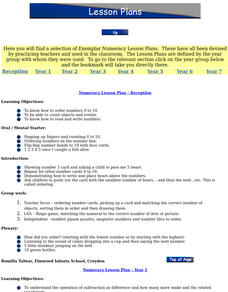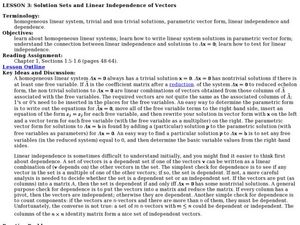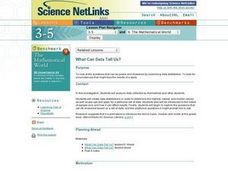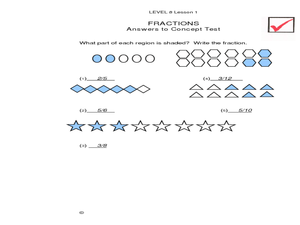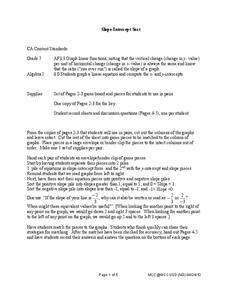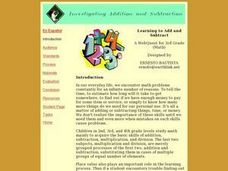Curated OER
Comparing Amounts
For this mathematics worksheet, 1st graders identify who has more money. Then they write how much each person has and circle the one with more money. Students also place a group of coins on their desk and write down how much they have.
Curated OER
Subtraction two-digit
Second graders identify two-digit numbers, learn value of giving, solve two-digit subtraction problems, and experience giving.
Curated OER
Numeracy Lesson Plan: Reception
Students examine number sense by participating in identification activities. For this number value lesson, students practice counting from 1-10, identifying number flash cards, reading clocks and multiplying basic numbers. Students...
Curated OER
Cuisenaire Chefs
Learners study the fractional values of Cuisenaire rods while working with favorite family recipes.
Curated OER
What's a Per-"cent"?
Students recognize the mathematical connections between fractions and percents. They develop and study graphs to make connections between their data and what it represents. They write about the connections they have discovered.
Curated OER
Solution Sets and Linear Independence of Vectors
Eleventh graders study homogeneous linear systems. In this linear system of equations lesson, 11th graders write linear system solutions in parametric vector form. Students also identify the connection between linear independence and...
Alabama Learning Exchange
Pizza! Pizza! Pizza!
Fifth graders practice using money in everyday situations. They use their addition and subtraction skills as they work in cooperative groups to solve problems involving decimals.
Alabama Learning Exchange
Find a Pattern Using Children's Literature
Sixth graders listen to Demi's, On Grain of Rice: A Mathematical Folktale. They use the problem solving strategy of finding a pattern to determine the number of rice Rani will receive after 30 days. They create a spreadsheet which...
Curated OER
Map Making/Floor Plans/Map Reading
Students apply their knowledge of scale when mapping the classroom. They determine the use of a map legend and orient a map using a compass. They create the classroom maps using transfer graph paper.
Curated OER
Maya Math: Addition and Subtraction
Students examine how ancient Maya counted, and practice addition and subtraction using Maya number glyphs.
Curated OER
Subtracting Greater Numbers
In this subtracting greater numbers worksheet, students, with a partner, problem solve and calculate the answers to six addition equations.
Fuel the Brain
Counting to Tens
Have your young mathematicians learned to count to one hundred? Do they know their groups of tens? If so, they might enjoy completing these word problems that have each of their sums end up being a group of ten!
Illustrative Mathematics
Find the Change
This exercise is an opportunity for algebra learners to understand the connection between the slope of a line and points found on the line. Use similar triangles to explain why slope m is the same between any two points. Discuss with the...
Curated OER
What Can Data Tell Us?
Students explore data distribution. In this data analysis lesson, students create a data distribution table by playing the game "Tower of Hanoi" from the Hall of Science. Students analyze their data and answer data driven questions.
Key Curriculum Press
Applications of Exponential Functions
Exponential functions are the name of the game. Young mathematicians can work through each of the eight worksheets by evaluating functions, applying logarithms, completing logarithmic functions, and building inverse functions. This would...
Curated OER
Fraction Games
Explore fractions with upper graders. They will discover how to show fractions by shading the correct amount shown in a picture (giving them the idea behind part to whole). They also play multiple fraction games using dice, matching...
Computer Science Unplugged
Lightest and Heaviest—Sorting Algorithms
How do computers sort data lists? Using eight unknown weights and a balance scale, groups determine the order of the weights from lightest to heaviest. A second worksheet provides the groups with other methods to order the weights. The...
Mathematics Vision Project
Module 3: Polynomial Functions
An informative module highlights eight polynomial concepts. Learners work with polynomial functions, expressions, and equations through graphing, simplifying, and solving.
West Contra Costa Unified School District
Slope-Intercept Sort
What's so special about slope? Pupils first match cards with slope and y-intercept to graphs of linear equations. They continue the lesson by matching equations in slope-intercept form to the same graphs.
Bowland
Fruit Pies
Scholars use formulas for the area of a circle and the area of a rectangle to determine the number of pies a baker can make from a particular area of dough. They must also take into account rolling the remaining dough into a new sheet.
Curated OER
Quinoa Pasta 3
A mixture of quinoa and corn is for dinner in this collaborative task that sets up nicely as a system of linear equations. Your supper guests discuss numerical precision and percentages as they formulate a plan of how to solve the problem.
Curated OER
Learning to Add and Subtract
Young learners practice addition and subtraction to solve problems. They use a webquest application to model how to solve math problems using pictures, words and numbers, and also practice using multiplication and division.
Curated OER
Operations with Fractions and Decimals
Complete a lesson plan that introduces and explores operations with fractions and decimals. Pupils estimate the reasonableness of a decimal computation. Then discuss what operation is needed to find an answer. Handouts, web sources, and...
Alabama Learning Exchange
Fun with Problem Solving
Using a varity of strategies, young mathematicians solve multistep word problems. They play a logic game as a whole group, and then work with a partner on a computer to complete a worksheet that requires a variety of problem solving...




